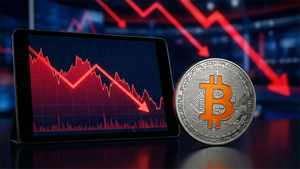
New York, NY – October 10, 2025 – In a rare convergence of positive performance, global financial markets closed the week of October 10, 2025, with U.S. stocks, bonds, and the U.S. dollar all registering weekly gains. This unusual synchronized rally has sparked optimism among investors, hinting at a potential "Goldilocks" economic scenario where growth remains resilient enough to bolster corporate profits while inflation moderates, paving the way for more accommodative monetary policy. The immediate implication is a surge in investor confidence, fueling a "risk-on" sentiment across asset classes, even as underlying complexities suggest a nuanced path forward.
This broad-based strength reflects a market grappling with, yet seemingly thriving amidst, a unique set of economic signals. While such simultaneous gains are often contradictory in traditional economic models, the current environment suggests a robust U.S. economy attracting global capital, coupled with evolving expectations around the Federal Reserve's future actions.
The Week's Unlikely Trio: Stocks, Bonds, and the Dollar Rise in Concert
The past week has seen a remarkable alignment in the performance of major asset classes. Equity markets, particularly in the U.S., have been propelled by stronger-than-expected Q3 corporate earnings and a persistent enthusiasm for artificial intelligence (AI). The S&P 500 Index surged, gaining over 2.5% for the week by midday on October 10, with the Nasdaq Composite leading the charge with even larger gains. The Dow Jones Industrial Average also posted significant advances, reflecting broad market optimism. This rally has been underpinned by a narrative of a successful "soft landing" for the U.S. economy, where disinflation is achieved without triggering a recession.
U.S. Treasury bonds also experienced gains, with yields falling as market participants increasingly priced in the conclusion of the Federal Reserve's hiking cycle. The benchmark 10-year Treasury yield dropped sharply after the September Consumer Price Index (CPI) report, falling by approximately 20 basis points over the week to around 4.10%. This decline, which pushed bond prices higher, was largely driven by critical inflation data released in early October, showing a significant deceleration in core inflation, bringing it closer to the Fed's 2% target. This fueled widespread expectations of interest rate cuts beginning in early 2026, boosting demand for fixed-income assets.
Concurrently, the U.S. Dollar Index (DXY) demonstrated significant strength, rising by roughly 1% for the week against a basket of major currencies and set for its best weekly advance in a year. The dollar's rally was primarily fueled by the comparative strength and resilience of the U.S. economy against other major global economies, which continue to grapple with slower growth or persistent inflationary pressures. Attractive absolute levels of U.S. interest rates, even with anticipated cuts, continued to draw capital inflows, and lingering global geopolitical uncertainties also contributed to some safe-haven demand for the greenback.
The positive market sentiment has been building over the past few weeks, catalyzed by a series of key economic data releases and central bank communications. In late September, the Federal Open Market Committee (FOMC) maintained interest rates, with Chair Jerome Powell's press conference hinting at encouraging signs of disinflation. This was followed by a stronger-than-expected Q2 GDP revision. Early October saw a September jobs report indicating continued strong job creation with moderating wage growth, and crucially, the September CPI report on October 8, which revealed a significant deceleration in core inflation. These events, combined with the unofficial commencement of Q3 corporate earnings season delivering optimistic results, have shaped the current bullish sentiment.
Winners and Losers: Navigating a Shifting Landscape
This broad market rally, driven by optimistic Q3 earnings, especially in technology and consumer discretionary, and a dovish Federal Reserve, is creating a dynamic environment with distinct winners and losers across various public companies and sectors.
Potential Winners:
- Information Technology (AI-focused companies): Companies deeply involved in artificial intelligence, semiconductors, and data centers are prime beneficiaries. Strong Q3 earnings and continued high demand for AI are significant tailwinds. Nvidia (NASDAQ: NVDA), Advanced Micro Devices (NASDAQ: AMD), Dell Technologies (NYSE: DELL), and Arista Networks (NYSE: ANET) have seen substantial gains due to surging demand for AI infrastructure and chips. Nvidia rose 2.2% on October 8 after its CEO noted a substantial increase in computing demand, while Dell surged 9% after raising its long-term outlook.
- Domestic-Focused Companies (Utilities, Telecommunications, REITs): A strong U.S. dollar benefits companies with predominantly domestic revenue streams as they are insulated from negative currency translation effects. Utilities, for instance, benefit from lower interest rates due to their capital-intensive nature and are supported by long-term trends like clean energy growth and data center energy demand.
- Select Consumer Discretionary & Staples: Robust consumer spending and lower import costs due to a strong dollar are beneficial. PepsiCo (NASDAQ: PEP) rose over 4% after better-than-expected Q3 net revenue, and Costco Wholesale (NASDAQ: COST) climbed 3.1% after strong monthly sales. Airlines like Delta Air Lines (NYSE: DAL) and United Airlines Holdings (NASDAQ: UAL) also saw significant gains after Delta raised its full-year adjusted EPS forecast.
- Financials: The sector has seen improved earnings expectations for Q3 2025 due to a "better combination of tailwinds," including tight credit spreads.
Potential Losers:
- Multinational Companies (Exporters and those with significant foreign revenue): A strong U.S. dollar makes American products and services more expensive for foreign buyers, reducing demand and market share abroad. When foreign revenues are converted back to USD, their value is diminished, directly impacting corporate earnings. Technology companies with a high percentage of international sales, despite the AI boom, can face headwinds.
- Homebuilders: This sector experienced declines on October 10, 2025. Companies like PulteGroup (NYSE: PHM) and Toll Brothers (NYSE: TOL) closed down more than 4% and 3% respectively after downgrades and concerns over artificially inflated home prices.
- Select Consumer Discretionary (Exposure to lower-income consumers or specific product issues): While the sector generally performed well, specific companies faced challenges. Tesla (NASDAQ: TSLA) slipped 0.7% after a safety investigation, and Ferrari (NYSE: RACE) sank 15% after issuing a soft outlook. Weak traffic data, particularly at restaurants, and concerns around the health of the low-income consumer are weighing on some holdings.
- Emerging Economies with Dollar-Denominated Debt: A strong U.S. dollar increases the cost for these nations to service their debts, potentially leading to financial strain and reduced export competitiveness.
Broader Implications: A "Goldilocks" Economy with Undercurrents
The concurrent rise in stocks, bonds, and the dollar is an unusual market phenomenon, often signaling contrasting economic narratives. One interpretation of these synchronized gains is a robust U.S. economy attracting global capital. A strong dollar can be fueled by economic resilience and higher yields on U.S. sovereign debt relative to other countries, drawing foreign direct investment. This influx of capital would logically support both bond prices and stock prices.
However, some analyses suggest that the simultaneous rise in U.S. stocks and bonds could reflect conflicting signals: bonds pricing in a slowing job market and potential Federal Reserve interest rate cuts, while stocks anticipate economic acceleration, particularly in the technology sector. The surge in gold prices, which surpassed $4,000 per ounce by October 2025 (a 50% year-to-date increase), further complicates this, indicating that investors may be seeking both growth and hedges against uncertainty or potential currency debasement, even as the dollar strengthens. This "debasement trade" reflects an erosion of confidence in traditional fiat currencies amidst concerns over government debt, inflation, and geopolitical instability, yet the dollar is still perceived as the "least weak" among major currencies.
The current market strength is significantly driven by artificial intelligence (AI) innovation, creating secular tailwinds and accelerating investment in data centers and AI capabilities. This technological advancement is a dominant force, boosting industries and shaping investment patterns. However, a strong dollar presents a mixed bag, leading to lower input costs for U.S. importers but creating headwinds for U.S. exporters and multinational corporations due to reduced competitiveness and diminished foreign earnings upon conversion.
The ripple effects are far-reaching. Emerging markets and commodity importers face tighter financial conditions and increased debt burdens due to a stronger dollar. European and Japanese markets, grappling with their own growth headwinds and political uncertainties, have seen their currencies weaken, reinforcing the dollar's comparative advantage. U.S. exporters and multinationals, particularly large technology and industrial manufacturing companies with substantial international operations, are vulnerable to reduced competitiveness.
The Federal Reserve's monetary policy plays a critical role. Recent Fed commentary has emphasized caution regarding rapid interest rate cuts, underscoring the durability of the U.S. economy. However, markets continue to price in expectations of multiple quarter-point rate cuts. If economic data remain firm, the Fed may slow the pace of easing, potentially extending dollar strength into 2026. Beyond monetary policy, regulatory actions also have a significant impact; while well-crafted regulations are essential, poorly implemented ones can impede growth.
Historically, the co-movement of stocks and bonds has varied. For the past two decades, long-term Treasury bonds often hedged portfolios against falling stock prices. However, periods like the 1980s and 1990s saw stocks and bonds rise and fall in tandem. The current broad market gains, therefore, could be seen as a period of relative strength and investor confidence in the U.S., but the conflicting signals (stocks vs. bonds, dollar vs. gold) suggest underlying complexities that differentiate it from purely optimistic rallies.
The Road Ahead: Opportunities and Challenges in a Complex Market
For the remainder of 2025, the market is walking a tightrope. The AI boom is expected to continue supporting technology stocks, but concerns about concentration risk and potential overvaluation persist. Further Federal Reserve rate cuts are anticipated, which would continue to support bond markets and provide a constructive backdrop for equities, provided inflation cooperates. However, sticky inflation, partly due to tariffs, could complicate the Fed's path, leading to increased market volatility.
Looking into 2026 and beyond, the outlook suggests a period of below-trend economic growth for the U.S., continued policy uncertainty, and evolving market dynamics. S&P Global Ratings forecasts U.S. GDP growth of 1.9% in 2025 and 1.8% in 2026, slightly below recent trends. Inflation is expected to remain above the 2% target in 2025 and 2026, supported by wage growth and persistent supply-side pressures. The labor market, while resilient, is forecasted to weaken gradually, with the unemployment rate potentially rising to 4.6% by mid-2026.
Investors will need to adapt to an environment of continued uncertainty, elevated valuations, and shifting economic fundamentals. Focusing on portfolio resilience, with a balance between growth-oriented assets and those providing downside protection, will be key. With anticipated rate cuts, opportunities may emerge in fixed income, particularly shorter maturities. While U.S. large-cap equities, especially in technology, financials, and utilities, are expected to continue outperforming, investors should also consider international equities for diversification and attractive valuations. Alternatives like diversified hedge funds and infrastructure investments can provide income and inflation hedges.
Market opportunities are abundant in AI innovation, monetary easing, and potentially undervalued sectors like real estate, energy, and healthcare. However, challenges include elevated valuations and concentration risk in a few AI-linked stocks, policy uncertainty around U.S. trade and fiscal policies, and the persistent threat of sticky inflation limiting the Fed's easing capabilities. A potential economic slowdown or even a recession in late 2026 remains a scenario to consider.
Final Verdict: Navigating Uncertainty with a Focus on Fundamentals
This week's market performance underscores its current sensitivity to central bank policy, geopolitical stability, and technological innovation. The Federal Reserve's cautious stance on inflation while acknowledging labor market concerns creates a delicate balancing act for monetary policy, the outcome of which will have lasting implications for asset valuations. The continued AI boom highlights a profound shift in economic drivers, making technology a dominant force that transcends immediate economic uncertainties.
Assessing the market moving forward, while the week offered pockets of strength, particularly in the tech-heavy segments of the stock market and for the U.S. dollar, underlying uncertainties suggest a cautious approach is warranted. The interplay of monetary policy, political stability, and technological innovation will define market performance in the final quarter of 2025.
Investors should closely monitor several key indicators in the coming months: the Federal Reserve's next steps regarding interest rates and its assessment of the dual mandate; the resolution of any ongoing U.S. government shutdown; the full Q3 earnings season, paying close attention to forward-looking guidance; global and domestic inflation trends; geopolitical developments; and the ongoing evolution of the AI sector. In conclusion, while the week presented an unusual display of broad market strength, adaptability and careful risk management will be paramount in the complex quarters ahead.
This content is intended for informational purposes only and is not financial advice





